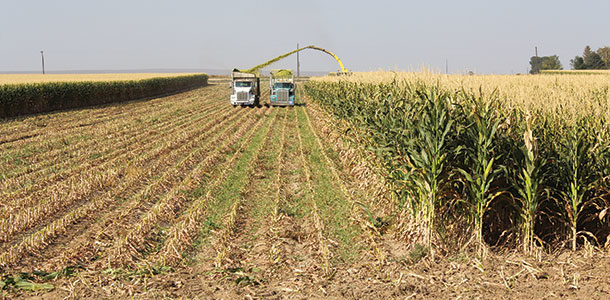An exciting three-year study of fresh corn fodder is under way in the Lone Star State to help determine optimum harvest times and effective corn varieties.
By specifically examining starch and fiber digestibility, the trial is helping to answer the nationwide question, “Is this corn a better value if sold for corn grain or fed to dairy cows as silage?”
The results from year one of the study show that trying to squeeze more starch out of the plant and increase total yield by delaying harvest may not be the best strategy for dairy producers.
Some samples high in starch proved to be unacceptable for cows. As the plant matures and kernel starch fill continues, the rumen digestibility of the starch declines. A hard kernel will pass right through a cow’s rumen without offering any nutritive value.
Starch is an important energy source and a key component of cow performance. A dairy cow requires a precise amount of starch in her diet in order to maximize milk production and maintain good health.
Ration decisions should not be based off of total starch inputs but rather the amount of rumen-degradable starch present, as this quantity reflects how much starch the cow can actually digest and utilize.
Conservatively speaking, a 2-pound increase in daily individual milk yield can be anticipated when starch is efficiently utilized.
The study began in 2014 and covered 16,000 acres of non-irrigated corn from 56 farms harvested over the course of 15 days. When harvesting began, dry matter was around 28 percent, but within two weeks, dry matter increased to between 36 and 37 percent with the bunker averaging 33 to 35 percent dry matter.
 Comparing 31 different corn silage hybrids, the study measured moisture, starch percent, starch digestibility, neutral detergent fiber (NDF) and NDF digestibility of 348 fresh-cut corn plant samples using GPN technology. (GPN measures how digestible and available starch will be to the rumen microbes. It is scored on an indexed scale of 1 to 11 where 1 equals slow-digesting and 11 equals fast-digesting.)
Comparing 31 different corn silage hybrids, the study measured moisture, starch percent, starch digestibility, neutral detergent fiber (NDF) and NDF digestibility of 348 fresh-cut corn plant samples using GPN technology. (GPN measures how digestible and available starch will be to the rumen microbes. It is scored on an indexed scale of 1 to 11 where 1 equals slow-digesting and 11 equals fast-digesting.)
Major variation in forage quality based on harvest time and hybrid selection were discovered. Starch content averaged 34 percent, but individual samples ranged from 18 to 48 percent.
The average GPN, or starch digestibility rating, averaged 6.8 while individual samples ranged from 5.8 to 7.8. The GPN score actually increased as moisture content went up, supporting the theory that harvesting less mature corn silage is conducive to gaining greater levels of starch digestibility.
As total starch content increased, rumen starch degradability decreased, showing that starch content and GPN are inversely related.
Therefore, waiting to let the ear fill completely to maximize total starch content may not provide optimum starch digestibility for dairy cows.

Although less mature corn silage contains lower quantities of starch, the starch is more digestible in the rumen, the kernels process better, and the higher moisture results in more favorable packing and provides better aerobic stability after opening the bunker.
Plant varieties exhibited notable differences in starch degradability and starch percent, proving that in addition to harvest timing, corn variety also plays a significant role.
Samples measuring under 30 percent starch were not always a result of excessive moisture, and those above 38 percent starch did not always show poor degradability of the starch.
Some early harvest varieties were found to be just as good as late-harvest varieties, and some of the late varieties were better than anticipated. Of course, the most desirable corn hybrid is one offering both high starch and high digestibility.

Length in storage is another factor to consider. While fresh samples provide a starting point, the GPN score you see immediately following harvest will not be the same three months down the road.
Starch digestibility increases the longer corn silage is stored, making routine testing critical in formulating rations that contain the correct amounts of digestible starch for maintaining consistent cow performance. It can also help save money by highlighting a reduction for the need of starch byproducts.
The ongoing study in Texas continues sampling every other week to gauge the impact of storage duration.
Years two and three of this study promise to uncover even more details regarding starch as it relates to harvest timing and hybrid selection with the goal of pinpointing which corn varieties are most effective to plant.
Choosing the optimum harvest time is critical to proper forage feedout and dependent on many factors, including geography and the growing conditions in your area as well as hybrid selection and kernel processing. Work closely with your nutritionist, agronomist and harvest team to establish a harvest timetable and make hybrid selections ideal for your farm and location. FG
References omitted due to space but are available upon request. Click here to email an editor.
PHOTO: Harvesting corn silage. Photo courtesy of Fredric Ridenour.

-
David C. Weakley
- Director, Dairy Forage Research
- Calibrate Technologies
- Email David C. Weakley











